It’s lagniappe time once again! Now that I’ve discussed the Aeroplan Mini-RTW trip in quite some detail, I wanted to offer a little something extra at the end.
In particular, in all the Aeroplan examples I’ve discussed on the blog, a lot of attention was focused on using miles to get to Europe and Asia. That’s because these spots seem to be the most popular among Canadian travellers, and also because Star Alliance coverage is relatively strong in these parts of the world.
But if you wanted to venture further afield – say, into the heart of Africa, or across the islands of the Pacific Ocean – would you be out of luck if you wanted to redeem Aeroplan miles?
Of course not! In fact, there’s quite a few “underrated” trips that are possible, courtesy of some unorthodox fifth-freedom Star Alliance routes (i.e., routes between two countries operated by an airline from a third country). Best of all, there are no fuel surcharges on any of them! So let’s go ahead and give some love to those destinations you might not have considered before.
1. The United Island Hopper
Any aviation geek worth their salt will be familiar with United Airlines Flight 154 and 155, which flies both ways from Guam to Honolulu via five tiny islands and atolls in the Pacific Ocean using a Boeing 737.
From west to east, the so-called “Island Hopper” flight departs Guam (GUM) and stops briefly in Chuuk (TKK), Pohnpei (PNI), Kosrae (KSA), Kwajalein Atoll (KWA), and Majuro (MAJ), before landing in Honolulu (HNL). Chuuk, Pohnpei, and Kosrae are part of the Federated States of Micronesia, while Kwajalein Atoll and Majuro belong to the Marshall Islands (the latter is the national capital). The flight has historically been operated to transport essential resources for the tiny populations of these US-affiliated islands.
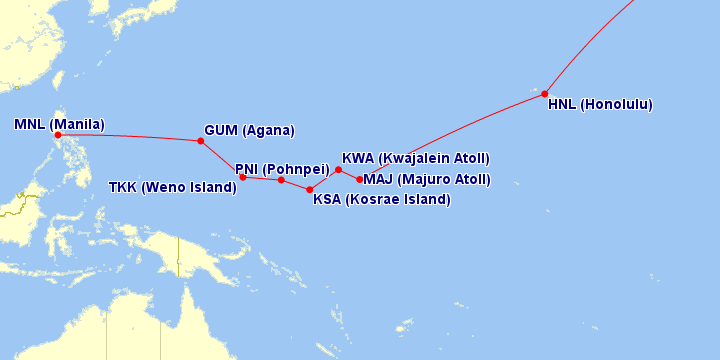
The scheduled stops are all very short (about 45-50 minutes per stop), but the beautiful thing is that by redeeming miles you’re allowed two free stopovers. So, if you included the Island Hopper as part of a larger Asia trip, for example, you could stay for a week in the beautiful Micronesian island of Pohnpei, or the rarely-visited Kosrae, home to about 6,600 residents.
It’s an amazing chance to catch a rare glimpse of what life is like in some of the world’s most remote islands very cheaply. The one place where a stopover probably wouldn’t be allowed is Kwajalein Atoll, which is home to an active US military base; civilians on Flights 154 and 155 aren’t even allowed to deplane during the scheduled stop.
From Guam, United flies onwards to Manila, Hong Kong, and Tokyo. Business class is offered on the Island Hopper, but don’t expect lie-flat seats and direct aisle access. This one is definitely more about the destination than the journey, anyway.
2. The Silk Road in the Air
Not only does Istanbul’s geographic location allow it to lay claim to being the only city in both Europe and Asia, it also affords Turkish Airlines the ability to fly to more countries in the world than any other airline by taking full advantage of its ideally positioned hub.
Some of Turkish’s routes, such as their six-times-weekly flights to Toronto and thrice-weekly flights to Montreal, make perfect sense for us Canadians. Others, however, can seem downright wacky at first glance. Take, for example, the below routing on Turkish.
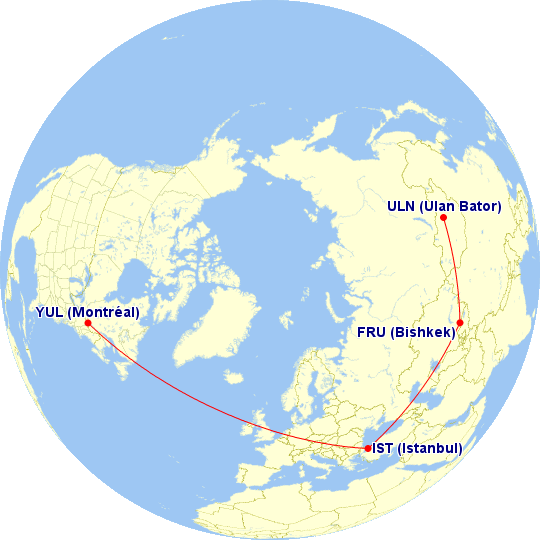
Turkish operates daily flights serving Bishkek (FRU), the capital of Kyrgyzstan, while it also has thrice-weekly onward service to Ulanbaatar (ULN) in Mongolia. This is an excellent way to travel to a region of the world that not many people get to visit. Make Bishkek your stopover or destination, for example, and you can easily hit up nearby Almaty in Kazakhstan as well. You could also rent a caravan and do a tour of all the ‘Stans before resuming your journey.
The above map only shows part of a possible round-trip – I doubt you’d be able to do the whole thing as a one-way, given MPM restrictions. Nonetheless, from Ulanbaatar, you have a few options for carrying on your trip. If Air China becomes bookable with Aeroplan again [UPDATE: it has], you could catch the direct flight to Beijing. Alternatively, hop on the Trans-Mongolian Railway to the Chinese capital and close your open-jaw from there!
Kyrgyzstan is classified by Aeroplan as the Middle East, so a round-trip would run you 80,000 miles in Economy or 165,000 miles in Business. There’s also visa costs to contend with, but that’s a small price to pay for those looking for faraway adventures.
3. The South Atlantic Explorer
Get ready to channel your inner Vasco da Gama with this one. In Part 2 of the Aeroplan Mini-RTW series I highlighted a “zigzag” routing that was possible from North America to South Africa, via Europe and Brazil, thrice crossing the Atlantic Ocean. I found the below variation even more intriguing.
The routing is made possible because Ethiopian Airlines uses Lomé, Togo (LFW), as a secondary hub, from which it operates long-haul flights to both New York and São Paulo. This makes another zigzag routing possible, this time via West Africa and Brazil (this routing falls just under the MPM for Vancouver to Johannesburg).
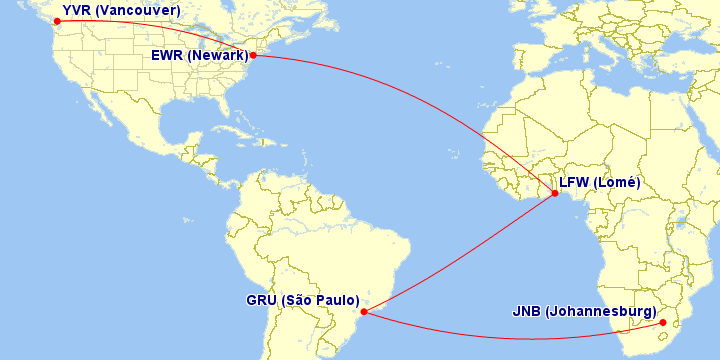
Africa is a truly vast continent, and the thought of travelling there can be daunting. Many travellers opt to get their first taste of Africa in a place like Egypt or South Africa, skirting around sub-Saharan Africa. In my opinion, having a stopover, at no additional cost, in a place like Togo is a great way to get introduced to the wider West Africa region as a whole and prepare yourself for a full trip sometime in the future.
Ethiopian operates its new Boeing 787 lie-flat business class on both transatlantic routes, so you can conquer the oceans in style if you so desire. The same is true for the South African Airways flight to Johannesburg, which is operated with their new A340 business class product as well.
4. The African Hopper
While Africa doesn’t have the extensive Star Alliance coverage of say Europe or Asia, Ethiopian Airlines and South African Airways do an amazing job of providing connectivity to such a vast continent. Not only do they serve many African and international destinations from their respective hubs, they also operate lots of fifth freedom flights (flights between two other countries) in and around the continent.
When you throw in there a few more of Turkish Airlines’s random fifth freedom flights (oh hey, twice-weekly TK543 from Bamako to Niamey, what are you doing there?) you get some pretty crazy routings that you can do.
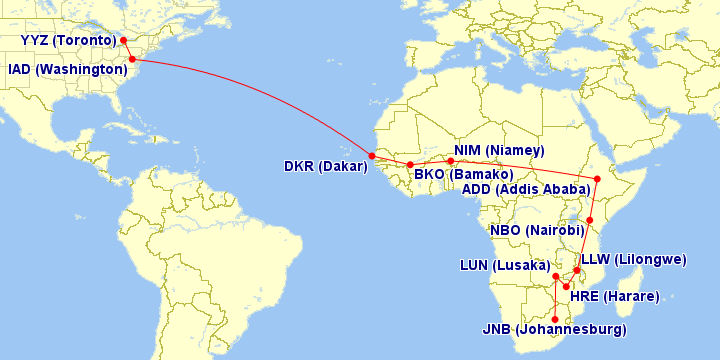
As with many examples on this blog, the above is an extreme-case illustration. It’d be hard to fit so many long layovers on this routing given how infrequently some of these routes are operated (some just once or twice a week). But I wanted to show you a few of the African cities that you might not think could be reached with Aeroplan miles. If you’re curious, here are the flights to look for:
- South African 208 from Washington, D.C. to Dakar, Senegal (3x weekly)
- Ethiopian 908 from Dakar to Bamako, Mali (6x weekly)
- Turkish 543 from Bamako to Niamey, Niger (2x weekly)
- Ethiopian 936 from Niamey to Addis Ababa, Ethiopia (4x weekly)
- Ethiopian from Addis Ababa to Nairobi, Kenya (4 flights a day)
- Ethiopian 51 from Nairobi to Lilongwe, Malawi (4x weekly)
- Ethiopian 35 from Lilongwe to Harare, Zimbabwe (2x weekly)
- Ethiopian 873 from Harare to Lusaka, Zambia (4x weekly)
- South African from Lusaka to Johannesburg, South Africa (4+ flights a day)
By no means do you have to follow this exactly. Feel free to pick and choose which parts of West and East Africa you’d like to explore, and for how long – remember that you have two stopovers and unlimited layovers on your round-trip Aeroplan ticket.
As an added bonus, here’s another possible “hopper” routing for West Africa, with lots of fifth-freedom fun.
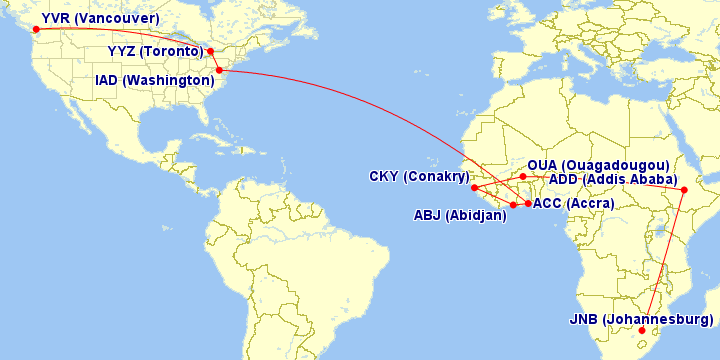
- South African 210 from Washington, D.C. to Accra, Ghana (4x weekly)
- South African 56 OR EgyptAir 881 from Accra to Abidjan, Côte d’Ivoire (3x and 1x weekly, respectively)
- Ethiopian 935 from Abidjan to Conakry, Guinea (5x weekly)
- Turkish 538 from Conakry to Ouagadougou, Burkina Faso (2x weekly)
- Ethiopian 926 from Ouagadougou to Addis Ababa (4x weekly)
As always, go wild and experiment on your own, and let me know what you come up with. This kind of trip certainly isn’t for everyone, but if you’re adventurous enough, it’s a mind-blowing way to get to South Africa!
Conclusion
There are quite a few creative and unexpected things you can do with Aeroplan if you look carefully, and in this article I’ve highlighted a handful that might be of interest. If you’ve ever bemoaned a lack of options for getting to places like the Micronesia, Central Asia, and sub-Saharan Africa on miles, I hope I’ve shown you that not all is lost. And if these places were never on your radar before, maybe you’ll be inspired to take one of these trips if you have the miles to burn.
This article (and the Aeroplan Mini-RTW series as a whole) has been a lot of fun to research and write. Over the course of these posts I’ve pretty much shared all of the sweet spots and unconventional routing tricks I know. Nevertheless, I’m sure more will pop up soon, and when that time comes you can be sure I’ll be posting about it!




















Hi Ricky, So I am wanting to book Victoria to Sydney N.S. and i was hoping to do some long layovers aong the way there or on the way back. Would I just search segment by segment and then call aeroplan to do the booking. I was thinking of Nashville and New Orleans as a layover. Would that be allowed or am I missing some restriction rules? Lol! I would also like to try this from Cairo to Kenya with some layovers along that route as well! Thank you for sharing some great information to all of us. Much appreciated as always!
Hey Marlene! Good to hear from you!
Yeah, definitely search segment by segment. It’s also good to familiarize yourself with the routes that fly to your airports of interest, before searching, just to know what to expect.
Since both BNA (Nashville) and MSY (New Orleans) are only served by Air Canada out of Toronto, you’ll definitely have to route creatively on United to make it work.
Cairo to Kenya would also be interesting – you could definitely make use of some of Ethiopian’s cool routes that I mentioned in this post. However note that Aeroplan charges quite a hefty amount for travel between North Africa and "East, West, and South Africa" – 65K roundtrip in economy and 120K in business.
Feel free to shoot me an email if you have any more questions!
Thank you again Ricky! I will have a look at cash fares from Cairo. Maybe some good old mistake fares will show up to get to Southern Africa. Im not in a time frame so can definitely take advantage of those. Haha! Thank you as always and we will be talking again Im sure!
Marlene
This is such a helpful roundup! I would love if you could include the amount of aeroplan points it took for each itinerary – I see that you do it for some of them 🙂
Thanks for the comment Madi! The amount of Aeroplan points required can be tricky since you can do these routings as part of different itineraries. For example, you could do the United Island Hopper as part of a North America to South Pacific trip, which would be 90K round-trip in Economy / 160K in Business. Or you could do it as part of North America to Asia, which would be 75K round-trip in Economy / 150K in Business.
For #3 and #4, North America to South Africa is 100K in Economy / 150K in Business. You can find the full award chart here: https://www.aeroplan.com/use-your-miles/flight-rewards-chart
Also gave your blog a follow! Always nice to hear from fellow Toronto travel bloggers 🙂
As with Pekflyer, I have seen that aeroplan rewards have decreased severely in the last number of weeks. Many of the airlines do not seem to be available now. Try tofind availability on Swiss, Belgian, Copa etc. It seems impossible even though a few weeks ago there was no problem.
I love your blogs that show how to get such interesting awards. I hateto be a conspiracy theorist, but boy oh boy the award universe seems to be changing fast.
Iam actualy thinking about cashing my points …… fast.
What do you think.
Or……..am I just nuts.
Honest answer please.
I just did a search for Brussels Airlines award space on ExpertFlyer and Aeroplan and Aeroplan is still accurately showing the award space. Sadly it’s just a matter of there not being much availability.
Hey John,
The honest answer is that just like all of us, I don’t know what’s happening and I have no idea what will happen next.
Having said that, I’m not panicking yet, and I’ll tell you why. It’s an undeniable truth that things change fast in the miles and points game. Things that are possible today may no longer be possible a year from now, but other things might be possible.
To give you an example, a few years ago, it was easy to get to Europe with Aeroplan without paying fuel surcharges (on Brussels, Swiss, Turkish, etc) but getting to Asia was quite hard. Singapore would block lots of partner space, EVA would only release close-in availability, and a bunch of airlines (ANA, Asiana, Thai) all had fuel surcharges. Now, that’s all changed. As you know there’s issues with Swiss on Aeroplan (I haven’t looked at Brussels), and Turkish is really the only carrier left that has good availability and no fuel surcharges. Conversely, however, EVA has started releasing very good availability, and fuel surcharge regulations have opened up Asia even more – no fuel surcharges on any flights to/from/within Japan, from/within Korea, and long-haul flights to/from Bangkok on Thai. For quite a while, Ethiopian has had very good availability but that may change soon in the future, who knows.
So the point is I’m still earning and burning miles because I’m still following the usual tenets of being flexible with dates and destinations, which means I can almost always find some availability that works. If Plan A doesn’t work out, I might figure out another way to get there and then use miles on the way back, or vice versa, or I might change my destination to a nearby place or change the dates I’m looking to fly. Any of these scenarios would still be better than paying cash outright, so I’ll keep collecting miles. Of course, I also collect other kinds of miles so that I’m not restricted to Aeroplan (Alaska miles for example).
For what it’s worth, I don’t think Aeroplan can keep playing the "technical issues" game much longer (or with more airlines) without risking some serious backlash.
Those are some of my thoughts on the situation, and I certainly hope the Aeroplan issues get resolved soon because it really is blatantly deceptive.
Thank you so much as always Ricky! You sure know your stuff and I do appreciate you sharing with all of us! I got a sweet deal to Israel so now I can’t wait to plan a rtw trip from over there!
Cheers, Marlene